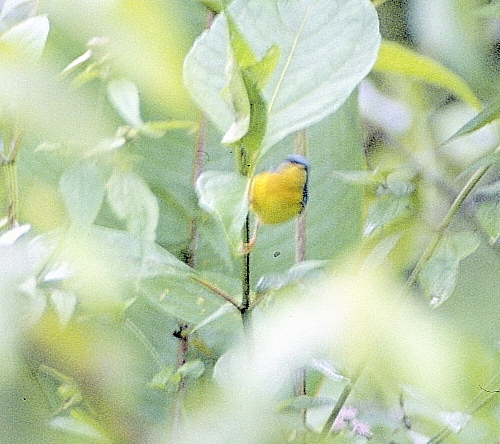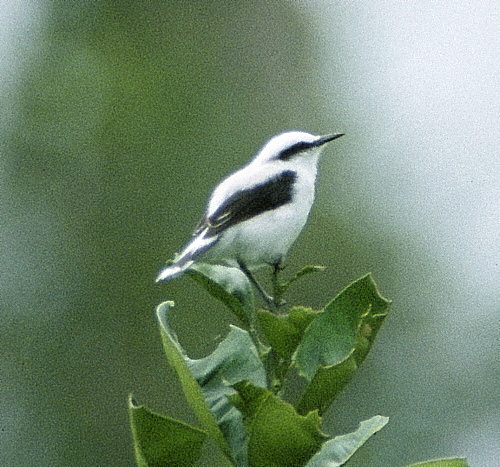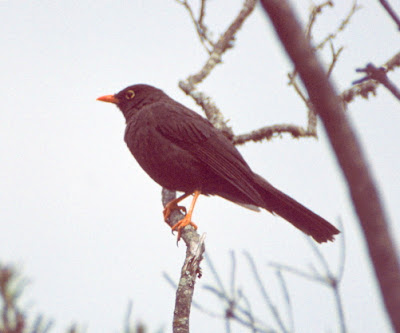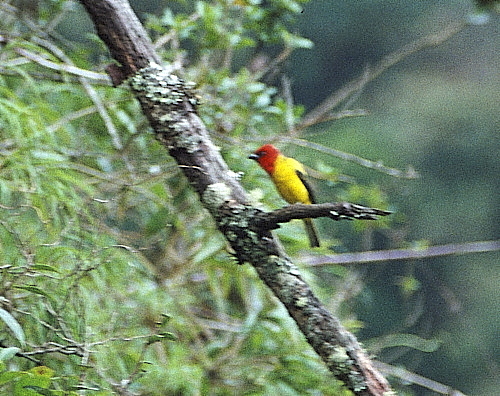Ecuador 1994 birding trip, our final blog to complete this trip.
Spot-billed Ground-Tyrant - Muscisaxicola maculirostris rufescens. Just one race involved. We saw around 6 in the vicinity of Laguna de Limpiopungo at Cotopaxi on the 27th. Uncommon to locally fairly common in open arid regions with sparse vegetation. Recorded mostly from 2400 to 3500 m.
Plain-capped Ground-Tyrant - Muscisaxicola alpina alpina Only seen at Cotopaxi above Laguna de Limpiopungo where 20 were seen on the 17th and 1 on the 27th. Also known as White-browed Ground-Tyrant. An uncommon austral visitor to paramo. pastures and fields of the temperate zone in the Andes, north to Pichincha. Most sightings during June to August period and it breeds in the Andes of central and S. Chile and Argentina, and recorded mainly from 2400 to 3700 m and occasionally as high as 4000m Our sighting on the 17th when twenty were seen probably related to migrants on the move.
Masked Water-Tyrant - Fluvicola nengeta atripennis We saw 6 around the Tinalandia. Superb. Fairly common in open and semiopen shrubby areas especially around marshes, ponds and along streams in the lowlands of W. Ecuador, and it ranges upto 800m. It reminded us of a rare Wheatear.
Social Flycatcher - Myiozetetes similis Seen along the old road to Santo Domingo, at Tinalandia, Rio Palenque and along the Nono Mindo road with a daily maximum of 40 seen at Tinalandia on the 19th.
Common to very commn in shrubby clearings, gardens, humid forests in the lowlands and foothills of both E. and W. Ecuador. It ranges up to 1400 m but is now spreading upwards in cleared areas.

White-capped Dipper - Cinclus leucocephalus leuconotus A single individual was seen on the Rio Bombuscara on the 11th with further singles seen along the Nono Mindo road on the 24th and above Papallacta Village on the 26th and 28th. Superb. We were delighted to see this superb looking Dipper as we have now seen all the Dipper species in the World. It is fairly common along fast flowing rocky streams on both slopes of the Andes, with elevation doesn't seem to matter if the right habitat is present.
Swainson’s Thrush - Catharus ustulatus swainsoni We saw up to eight daily at the Rio Bombuscara, one in the parking lot at Tinalandia and six along the road to the obelisk above Mindo on the 23rd. Uncommon boreal winter visitor in the lower growth forests, borders, secondary woodlands and clearings in the lowlands. It is considerably more numerous in E. Ecuador than it is in the west.
Great Thrush - Turdus fuscater. Seen on fifteen dates with a daily maximum of 40 recorded on three dates at Cotopaxi, Pasochoa and the Tandayapa Pass area. Common at borders of montane forests, secondary woodlands and clearings in agricultural areas with hedgerows. It is one of the most seen birds in the city of Quito, and recorded mostly from 2500 to 4000 m. Two races occur in Ecuador.

Chestnut-bellied Thrush - Turdus fulviventris We saw 2 of this attractive thrush along the Rio Bombuscara trails on both the 12th and 13th Uncommon and rather local in the lower growth of montane forests and forest borders on the east slope of the Andes. It is not a very reported Thrush and appears to be more numerous in S. Ecuador than in the north. Wanderers are observed on several occasions in the Bombuscafro sector of the Podocarpus Nat. Park. at 1000 to 1100 m.
Turquoise Jay - Cyanoleuca turcosa. At the Cajanuma Cabin we saw 2 on the 9th and 1 on the 15th. Pairs were seen along the Old Santo Domingo Road and on two dates along the Nono Mindo Road.
Fairly common and widespread in montane forests and adjacent clearings on both slopes of the Andes. Most numberous from 2000 to 3000 m.

Record shot of a Tropical Parula – Parula pitiayumi We saw 2 along the Rio Bombuscara Trail on the 13th and up to 8 were seen on three dates in the Nono Mindo area. Common in a variety of forested and wooded habitats in W. Ecuador, but it avoids very wet forests. It ranges from the lowlands up to 2000m
.
Cinereous Conebill – Conirostrum cinereum fraseri. We saw around 8 near Quito Airport on the 8th and similar numbers were seen at La Cienega, Cotopaxi, along the Nono Mindo road and at Papallacta on four other dates. Uncommon to fairly common in shrubby areas. Recorded mostly from 2500 to 3500 m
Magpie Tanager – Cissopis leveriana leveriana. Only seen along the Rio Bombuscara where we saw 6 on the 11th and 3 on the 13th. Common on the borders of humid forests, secondary woodland, and trees in adjacent clearings in the lowlands of E. Ecuador. Ranges upto cleared areas in the foothills to about 1200 m.
A distant White-winged Tanager – Piranga leucoptera. Just one race occurs and singles were seen on four days around Mindo. Superb. Uncommon in the canopy and borders of montane forests and adjacent clearings in the foothills on both slopes of the Andes. Ranges from 800 to 1800 m.
Red-hooded Tanager – Piranga rubriceps. We saw 6 along the entrance road to Cajanuma Cabin on the 10th. Rare to locally uncommon in the canopy and boarders of montane forests on the E. slope of the Andes, and on ther W. slope in the north. Recorded from 2200 to 3000 m.
Poor pictures of a stunning Blue Winged Mountain-Tanager Anisognathus somptuosus
We saw up to 7 on three dates in the Nono Mindo areas. Fairly common in montane forests, and secondary woodlands on both slopes of the Andes. Four races are recorded, and it ranges from 1200 to 2500 m.
Paradise Tanager – Tangara chilensis chilensis. We saw up to 25 daily along the Rio Bombuscara proving much easier than anticipated. Fairly common in humid forest, secondary woodland and clearings with scattered trees in the lowlands and foothills of E. Ecuador. Occurs mostly below 1200 m upto 1700m and it is most numerous along the base of the Andes.
Swallow Tanager – Tersina viridis occidentalis. We saw a single male at Tinalandia on the 19th and a pair at Mindo on the 22nd. Fairly common in humid forest boarders, secondary woodland and especially clearings in the foothills on both slopes of the Andes. Numbers seem to vary seasonally in many or all areas.. Just one race occurs in Ecuador
.
Plumbeous Sierra-Finch – Phrygilus unicolor geospizopsis One race and. we saw up to 25 daily at both Cotopaxi and Papallacta Pass. Fairly common in the paramo and shrubbery neasr the treeline in the Andes, and is recorded mostly between 3000 to 4300 m.
Black Flowerpiercer – Diglossa humeralis aterrima. We saw small numbers at La Cienega, Cotopaxi, along the Nono Mindo road and at Papallacta Pass on a total of five dates. One race occurs in Ecuador, Common in montane forests, woodland, shrubby areas, and gardens on both slopes of the Andes. Usually recorded from 2500 to 4000 m. This picture shows the sharp bill for piercing the flowers.
Rufous-collared Sparrow – Zonotrichia capensis costaricensis. Seen on eleven dates in large numbers.
Common and widespread. Recorded mostly between 1500 to 3500m. Just one race occurs in Ecuador.
Russet-backed Oropendola – Psarocolius angustifrons atrocastaneus. We saw around 15 along the Nono Mindo Road on the 25th. Common and widespread in the canopy and boarders of humid forests, adjacent clearings, and especially along river shorelines in the lowlands of E. Ecuador. In the east it occurs upto 2000m. on the east slope of the Andes, and on the west slope ranges between 1000 to 2100m. Three different races are found in Ecuador.
Flowers and Orchids found along the Rio Bombuscara Trail, Podacarpus Nat. Park.
Cotopaxi Volcano at night.
During our three week trip we identified a total of 314 different species of which a good number were new species for ourselves. Although we tried to photograph as many species as possible, using the old system of cameras with films, we would have done a lot better with the photography now using our digital Canon cameras.and lenses.
We were unable to photograph a number of the rerer species seen during the trip, but we did record these following species which we were unable to photograph but were still very pleased to see them..
Andean Guan, Sickle-winged Guan, Sunbittern, Noble Snipe, Rufous-banded Owl, Booted Racket Tail, Golden Headed Quetzal, Blue Crowned Motmot, Coppery Chested Jacamar, Toucan Barbet, Stripe Billed Aracari, Black Headed Antthrush, to name just a few.
Acknowledgements: Many thanks to a number of other observers who kindly supplied us with details of their previous trips to Ecuador, and also for kindly sending us copies of their tape recordings of bird calls and songs for use in Ecuador.
Also the two vol. "Birds of Ecuador" by Ridgely and Greenfield, as a useful reference, used in this report.










































